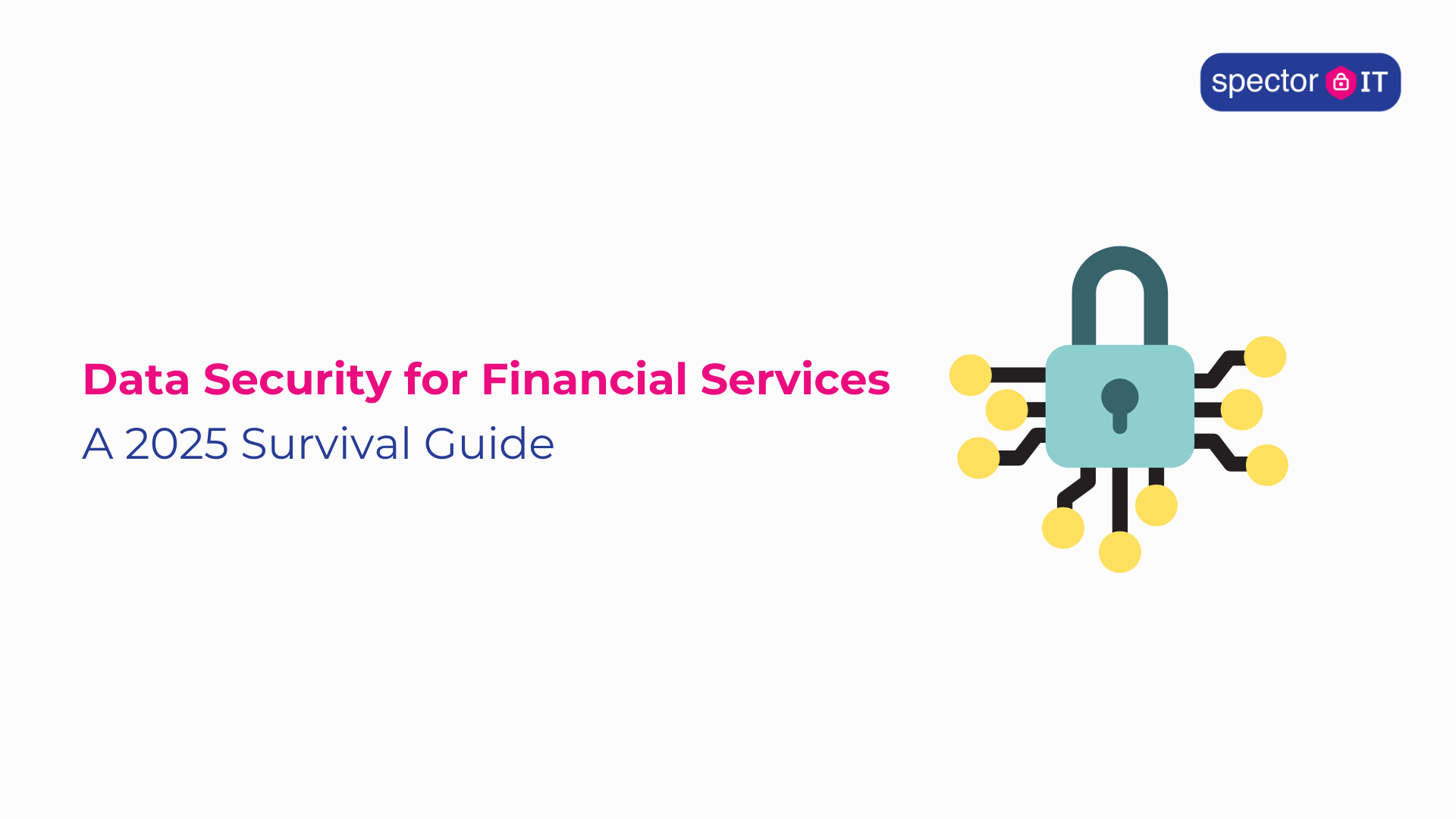
Data Security for Financial Services: A 2025 Survival Guide
Data security for financial services is no longer optional—it’s a business imperative. At Spector IT, we help accountants, credit unions, investment firms, and wealth managers build robust systems that protect client trust, meet compliance standards, and support operations seamlessly.
As we navigate 2025, financial data is more valuable than ever. Sophisticated threat actors target institutions with advanced phishing, ransomware, and insider attacks. That’s why a holistic and proactive approach to data security for financial services matters now more than ever.
Why 2025 Demands Next-Level Data Security for Financial Services
The regulatory and threat landscapes have shifted dramatically:
-
GDPR and DORA carry stiffer fines for data breaches
-
Hybrid work environments introduce more access points
-
Ransomware-as-a-Service gangs are targeting finance
-
Supply chain vulnerabilities through third-party tools
These factors mean a reactive security posture won’t suffice. You must adopt a proactive, multi-layered strategy to safeguard data, reputation, and customer relationships.
Read more on Top Challenges for Small Financial Firms in Achieving DORA Compliance
5 Essential Pillars of Data Security for Financial Services in 2025
1. Encrypt Everything — At Rest and in Transit
Encrypting only hard drives isn’t enough. Protect data moving between apps, emails, SaaS systems, and backups too. Use TLS 1.2+ for transit and AES-256 for data at rest. For compliance guidance, see the European Banking Authority’s IT Security Guidelines.
2. Secure Access with MFA and Zero Trust
Passwords alone are a weak link. Implement multi-factor authentication (MFA) across the board and consider a Zero Trust model where every access request is verified. Financial regulators expect controls aligned with Zero Trust best practices for 2025.
3. Build AI-Enhanced Threat Detection
Leverage built-in tools like Microsoft Defender for Office 365 and Azure Sentinel for real-time anomaly detection—flagging unusual login locations, mass downloads, or suspicious bulk payments. These tools interpret context, not just signatures.
4. Train Users and Simulate Phishing
Human error remains the primary vulnerability. Run quarterly phishing tests and deliver 5-minute micro-trainings on red flags, such as “Invoice attached? Confirm via phone.” This builds awareness and proactive reporting.
5. Ensure Backup Resilience and Rapid Recovery
Ransomware is a reality. Use a 3-2-1-1 backup strategy: three copies, two local, one offsite, one off-network. Test recovery drills bi-annually. Tools like Azure Backup or Veeam work well, but testing is non-negotiable.
The Evolving Landscape: Trends Shaping Data Security in Financial Services
A. Regulatory Evolution
Expect updates to GDPR enforcement and new EU DORA rules for digital resilience. UK’s Financial Conduct Authority is also updating cyber guidance. Incorporate these into your roadmap now.
B. Cloud-Native & API Risk
As financial systems migrate to cloud-native setups and API integrations, new vulnerabilities appear. Partner with providers skilled in managing IAM and API auditing.
C. Third-Party Risks
Banking and fintech alike rely on vendors. Require vendor security reports or SOC 2 Type II attestations.
A Practical 90-Day Plan to Boost Data Security for Financial Services
Weeks: 1-2
- Focus Area – Full security review
- Actions – Audit encryption, MFA, backups; identify gaps
Weeks: 3–4
- Focus Area – Deploy detection
- Actions – Turn on Microsoft Defender logs and alerts
Weeks: 5–6
- Focus Area – Launch phishing training
- Actions – Run simulation and track report/click metrics
Weeks: 7–8
- Focus Area – Strengthen backups
- Actions – Test recovery from latest backup
Weeks: 9–10
- Focus Area – Vendor & API audit
- Actions – Review top 5 vendor contracts and APIs
Weeks: 11–12
- Focus Area – Board-level metrics
- Actions – Compile KPI dashboard and schedule executive briefing
Key Metrics Financial Firms Should Track
-
Encryption Coverage – aim for 100% on key databases and file stores
-
MFA Adoption – objective: 100% across staff
-
Phishing Report Rate – target ratio > 1:1
-
Backup Test Success – > 95% reliability
-
Mean Time to Detect (MTTD) – < 30 minutes
-
Audit/Incident Response Drills Completed – 2/year
These metrics help demonstrate ROI, strengthen board confidence, and prepare for audits.
Overcoming Common Obstacles in Data Security for Financial Services
-
Topology Blind Spots – Unmonitored SaaS or legacy systems.
Fix: Map all systems and onboard them into SIEM.
-
Detection Burnout – Excessive false alerts.
Fix: Only alert on high-confidence events, tune rules monthly.
-
Vendor Vulnerabilities – Your partner becomes the weak link.
Fix: Contractual security requirements and quarterly vendor reviews.
-
Skill Overload – Staff are stretched thin.
Fix: Outsource monitoring or invest in managed detection services.
Why Work with Spector IT for Data Security in Financial Services
As specialists in financial-sector IT, we:
-
Tailor encryption and access policies to your compliance needs
-
Deploy rapid detection using Microsoft and Azure tools
-
Run phishing campaigns and train staff on ongoing risks
-
Audit backups and recovery workflows
-
Provide clear metrics and dashboards for leadership
Our clients benefit from strengthened security posture, reduced incident costs, and improved compliance.
Ready to Enhance Your Data Security for Financial Services?
Book a free 30-minute Data Security Strategy Call to:
-
Review your existing setup and uncover gaps
-
Map improvements against key regulations (GDPR, DORA)
-
Define a 90-day action plan with retention, detection, and recovery milestones
Schedule your call with Spector IT today
Post updated on 30/06/2025

